Flexible display
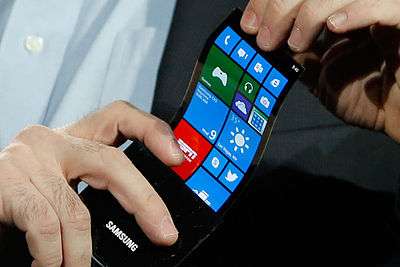
A flexible display is an electronic visual display which is flexible in nature; differentiable from the more prevalent traditional flat screen displays used in most electronics devices. In the recent years there has been a growing interest from numerous consumer electronics manufacturers to apply this display technology in e-readers, mobile phones and other consumer electronics.
History
Flexible electronic paper based displays
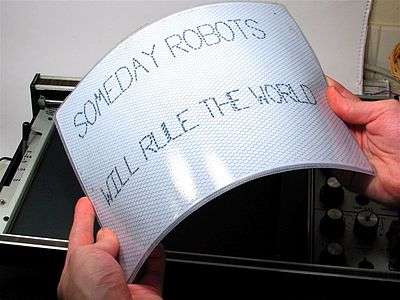
Flexible electronic paper (e-paper) based displays were the first flexible displays conceptualized and prototyped. Though this form of flexible displays has a long history and were attempted by many companies, it is only recently that this technology began to see commercial implementations slated for mass production to be used in consumer electronic devices.
Xerox PARC
The concept of developing a flexible display was first put forth by Xerox PARC (Palo Alto Research Company). In 1974, Nicholas K. Sheridon, a PARC employee, made a major breakthrough in flexible display technology and produced the first flexible e-paper display. Dubbed Gyricon, this new display technology was designed to mimic the properties of paper, but married with the capacity to display dynamic digital images. Sheridon envisioned the advent of paperless offices and sought commercial applications for Gyricon.[1] In 2003 Gyricon LLC was formed as a direct subsidiary of Xerox to commercialize the electronic paper technology developed at Xerox PARC.[2] Gyricon LLC's operations were short lived and in December 2005 Xerox closed the subsidiary company in a move to focus on licensing the technology instead.[3]
HP and ASU
In 2005, Arizona State University opened a 250,000 square foot facility dedicated to flexible display research named the ASU Flexible Display Center (FDC). ASU received $43.7 million from the Army Research Lab towards the development of this research facility.[4] A planned prototype device was slated for public demonstration later that year.[5] However, the project met a series of delays. In December 2008, ASU in partnership with Hewlett Packard demonstrated a prototype flexible e-paper from the Flexible Display Center at the university.[6] HP continued on with the research, and in 2010, showcased another demonstration.[7] However, due to limitations in technology, HP stated "[our company] doesn't actually see these panels being used in truly flexible or rollable displays, but instead sees them being used to simply make displays thinner and lighter."[7]
Plastic Logic
This company develops and manufactures monochrome plastic flexible displays in various sizes based on its proprietary organic thin film transistor (OTFT) technology. They have also demonstrated their ability to produce colour displays with this technology, however they are currently not capable of manufacturing them on a large-scale.[8][9][10] The displays are manufactured in the company's purpose-built factory in Dresden, Germany, which was the first factory of its kind to be built - dedicated to the high volume manufacture of organic electronics.[11] These flexible displays are cited as being "unbreakable", because they are made completely of plastic and do not contain glass. They are also lighter and thinner than glass-based displays and low-power. Applications of this flexible display technology include signage,[12][13] wristwatches and wearable devices[14] as well as automotive and mobile devices.[15]
Organic User Interfaces and the Human Media Lab
In 2004, a team led by Prof. Roel Vertegaal at Queen's University's Human Media Lab in Canada developed PaperWindows,[16] the first prototype bendable paper computer and first Organic User Interface. Since full-colour, US Letter-sized displays were not available at the time, PaperWindows deployed a form of active projection mapping of computer windows on real paper documents that worked together as one computer through 3D tracking. At a lecture to the Gyricon and Human-Computer Interaction teams at Xerox PARC on May 4, 2007, Prof. Vertegaal publicly introduced the term Organic User Interface (OUI) as a means of describing the implications of non-flat display technologies on user interfaces of the future: paper computers, flexible form factors for computing devices, but also encompassing rigid display objects of any shape, with wrap-around, skin-like displays. The lecture was published a year later as part of a special issue on Organic User Interfaces[17] in the Communications of the ACM. In May 2010, the Human Media Lab partnered with ASU's Flexible Display Center to produce PaperPhone,[18] the first flexible smartphone with a flexible electrophoretic display. PaperPhone used bend gestures for navigating contents. Since then, the Human Media Lab has partnered with Plastic Logic and Intel to introduce the first flexible tablet PC and multi-display e-paper computer, PaperTab,[19] at CES 2013, debuting the world's first actuated flexible smartphone prototype, MorePhone[20] in April 2013.
Others
Since 2010 Sony Electronics, AU Optronics and LG Electronics have all expressed interest in developing flexible e-paper displays.[21][22] However, only LG have formally announced plans for mass production of flexible e-paper displays.[23]
Flexible OLED-based displays
Research and development into flexible e-paper-based displays largely began in late 2000s with the main intentions of implementing this technology in mobile devices. However, this technology has recently made an appearance, to a moderate extent, in consumer television displays as well.
Nokia Morph and Kinetic concepts
Nokia first conceptualized the application of flexible OLED displays in mobile phone with the Nokia Morph concept mobile phone. Released to the press in February 2008, the Morph concept was project Nokia had co-developed with the University of Cambridge.[24] WIth the Morph, Nokia intended to demonstrated their vision of future mobile devices to incorporate flexible and polymorphic designs; allowing the device to seamlessly change and match a variety of needs by the user within various environments.[25] Though the focus of the Morph was to demonstrate the potential of nanotechnology, it pioneered the concept of utilizing a flexible video display in a consumer electronics device.[25] Nokia renewed their interest in flexible mobile devices again in 2011 with the Nokia Kinetic concept.[26] Nokia unveiled the Kinetic flexible phone prototype at Nokia World 2011 in London, alongside Nokia’s new range of Windows Phone 7 devices.[27] The Kinetic proved to be a large departure from the Morph physically, but it still incorporated Nokia's vision of polymorphism in mobile devices.[26]
Sony

Sony Electronics expressed interest for research and development towards a flexible display video display since 2005.[28] In partnership with RIKEN (the Institute of Physical and Chemical Research), Sony promised to commercialize this technology in TVs and cellphones sometime around 2010.[28] In May 2010 Sony showcased a rollable TFT-driven OLED display.[29]
Samsung
In late 2010, Samsung Electronics announced the development of a prototype 4.5 inch flexible AMOLED display.[30] The prototype device was then showcased at Consumer Electronics Show 2011.[31] During the 2011 Q3 quarterly earnings call, Samung’s vice president of investor relations, Robert Yi, confirmed the company’s intentions of applying the technology in handsets and added "… we are looking to introduce [the flexible displays] sometime in 2012, hopefully the earlier part."[32] In January 2012 Samsung acquired Liquavista, a company with expertise in manufacturing flexible displays, and announced plans to begin mass production by Q2 2012.[33][34] During Samsung's CES 2013 keynote presentation, two prototype mobile devices that incorporated the flexible AMOLED display technology were shown to the public.[35]
On 8 October 2013, the Samsung Galaxy Round was unveiled as the world's first mobile phone with flexible display.[36] Featuring a 5.7" touchscreen display made of flexible material, the phone (and the screen) were curved in shape but the phone itself was solid, thus not allowing its body or the screen to be bendable. The Samsung Galaxy Round was 7.9mm thick and weighed 154 grams.[37] The smartphone ran on Android 4.3 Jelly Bean operating system and was sold for $1000 upon release.
At the 2013 Consumer Electronics Show, Samsung presented "Youm"—concept prototypes for smartphones that incorporated flexible displays. One prototype had a screen curved along the right edge of the phone, while the other had a screen curved around the bottom of the phone. Samsung explained that the additional "strip" could be used to display additional information alongside apps, such as notifications or a news ticker. That Youm concept would surface as part of the Samsung Galaxy Note Edge.
ASU
The Flexible Display Center (FDC) at Arizona State University announced a continued effort in forwarding flexible displays in 2012.[38] On May 30, in partnership with Army Research Lab scientists, ASU announced that it has successfully manufactured the world's largest flexible OLED display using thin-film transistor (TFTs) technology.[39] ASU intends the display to be used in "thin, lightweight, bendable and highly rugged devices."[39]
Technical details
Electronic paper
Flexible displays using electronic paper technology commonly use Electrophoretic or Electrowetting technologies. However, each type of flexible electronic paper vary in specification due to different implementation techniques by different companies.
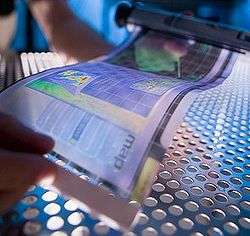
HP and ASU e-paper
The flexible electronic paper display technology co-developed by Arizona State University and HP employs a manufacturing process developed by HP Labs called Self-Aligned Imprint Lithography (SAIL).[40] The screens are made by layering stacks of semi-conductor materials and metals between pliable plastic sheets. The stacks need to be perfectly aligned and stay that way. Alignment proves difficult during manufacturing when heat during manufacturing can deform the materials and when the resulting screen also needs to remain flexible. The SAIL process gets around this by ‘printing’ the semiconductor pattern on a fully composed substrate, so that the layers always remain in perfect alignment. The limitation of the material the screen is based on allows only a finite amount of full rolls, hence limiting its commercial application as a flexible display.[7] Specifications provided regarding the prototype display are as follows:
Asu e-paper
The flexible electronic paper display announced by AUO is unique as it is the only solar powered variant. A separate rechargeable battery is also attached when solar charging is unavailable.[41] Specifications[21]
- 6-inch diagonal display size
- radius of curvature can reach 100mm
- 9:1 high contrast ratio
- reflectance of 33%
- 16 gray levels
- solar powered
- "unbreakable"
LG e-paper
Specifications:[42]
- 6-inch diagonal display size
- 1024x768 (XGA) resolution
- 4:3 aspect ratio
- TFT based electronic display
- "allows bending at a range of 40 degrees from the center of the screen"
- 0.7mm thickness from the side
- 14g weight
- can drop from 1.5m above ground with no resultant damage
- "unbreakable" (from tests with a small urethane hammer)
List of displays by their reported curvature
| Model | Diagonal (in) | Radius of curvature* | Curved along its wider / shorter side? |
|---|---|---|---|
| Samsung Round | 5.7 | 400 millimetres (16 in) | shorter |
| LG G Flex | 6 | 700 millimetres (28 in) | wider |
| Samsung KN55S9C | 54.6 | 4,500 millimetres (180 in) | wider |
| LG 55EA9800 | 54.6 | 5,000 millimetres (200 in) | wider |
*Lower is more sharply curved
OLED
Many of the e-paper based flexible displays are based on OLED technology and its variants. Though this technology is relatively new in comparison with e-paper based flexible displays, implementation of OLED flexible displays saw considerable growth in the last few years.
ASU
Specifications:[43]
- 6-inch diagonal display size
- 480x360 4k resolution
- 4:3 aspect ratio
- OLED display technology with a TFT back plane
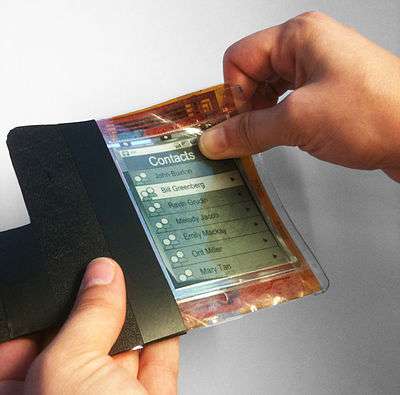
Samsung
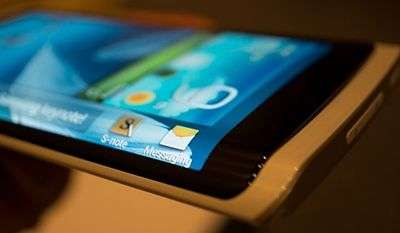
- 4.5-inch diagonal display size[31]
- 800x480 WVGA , 1280x720 WXGA and WQXGA (2560×1600) resolutions[45]
- AMOLED display technology
- "unbreakable"
Concept devices
Mobile devices
In May 2011, Human Media Lab at Queen's University in Canada introduced PaperPhone, the first flexible smartphone, in partnership with the Arizona State University Flexible Display Center.[18] PaperPhone used 5 bend sensors to implement navigation of the user interface through bend gestures of corners and sides of the display. In January 2013, the Human Media Lab introduced the first flexible tablet PC, PaperTab,[19] in collaboration with Plastic Logic and Intel Labs, at CES. PaperTab is a multi-display environment in which each display represents a window, app or computer document. Displays are tracked in 3D to allow multidisplay operations, such as collate to enlarge the display space, or pointing with one display onto another to pull open a document file. In April 2013 in Paris, the Human Media Lab, in collaboration with Plastic Logic, unveiled the world's first actuated flexible smartphone prototype, MorePhone.[20] MorePhone actuates its body to notify users upon receiving a phone call or message.
Nokia introduced the Kinetic concept phone at Nokia World 2011 in London.[26] The flexible OLED display allows users to interact with the phone by twisting, bending, squeezing and folding in different manners across both the vertical and horizontal planes.[46] The technology journalist website Engadget described interactions such as "[when] bend the screen towards yourself, [the device] acts as a selection function, or zooms in on any pictures you're viewing."[47] Nokia envisioned this type of device to be available to consumers in "as little as three years", and claimed to already possess "the technology to produce it."[26]
At CES 2013, Samsung showcased the two handsets which incorporates AMOLED flexible display technology during its keynote presentation, the Youm and an unnamed Windows Phone 8 prototype device.[48][49] The Youm possesses a static implementation of flexible AMOLED display technology, as its screen has a set curvature along one of its edges.[45] The benefit of the curvature allows users "to read text messages, stock tickers, and other notifications from the side of the device even if [the user] have a case covering the screen."[45] The screen is described to be a 16:9 aspect ratio at a 720p resolution.[45] The unnamed Windows Phone 8 prototype device is composed of a solid base from which extends a flexible AMOLED display.[49] The AMOLED display itself bends and was described as "virtually unbreakable even when dropped" according to Samsung representatives.[35] Brian Berkeley, the senior vice president of Samsung Display, believes that this flexible form factor "will really begin to change how people interact with their devices, opening up new lifestyle possibilities ... [and] allow our partners to create a whole new ecosystem of devices."[35]
ReFlex is a flexible smartphone created by Queen’s University’s Human Media Lab.[50]
Curved OLED TVs
LG Electronics and Samsung Electronics both introduced curved OLED televisions with a curved display at CES 2013 hours apart from each other.[51][52] Both companies recognized their respective curved OLED prototype television as a first-of-its-kind due to its flexed OLED display.[53][54] The technology journalist website The Verge noted the subtle curve on 55" Samsung OLED TV allowed it to have a "more panoramic, more immersive viewing experience, and actually improves viewing angles from the side."[51] The experience was also shared viewing the curved 55" LG OLED TV. It should be noted that the LG set is also 3D capable, in addition to the curvature.[52]
| Model | Diagonal (in) | Radius of curvature (mm)* |
|---|---|---|
| Samsung KN55S9C | 54.6 | 4,500[55][56][57] |
| LG 55EA9800 | 54.6 | 5,000[55][56][57] |
*Lower is more sharply curved
See also
- Organic user interface (OUI), the category of user interfaces commonly implemented on consumer devices with flexible displays.
References
- ↑ Iddo Genuth (15 October 2007). "The Future of Electronic Paper". The Future of Things. Retrieved 12 February 2013.
- ↑ Xerox PARC (9 December 2003). "Gyricon LLC and the World of Electronic Paper". Xerox PARC. Retrieved 12 February 2013.
- ↑ Brian Hamilton (15 December 2005). "Xerox erases electronic paper subsidiary, Gyricon LLC, in Scio Twp". Ann Arbor Business Review. Retrieved 12 February 2013.
- ↑ Arizona State University (Spring 2005). "ASU, Army Open New Flexible Display Center". Arizona State University. Retrieved 12 February 2013.
- ↑ Marc Perton (9 February 2005). "Arizona State opens flexible-display center". Engadget. Retrieved 12 February 2013.
- 1 2 Brian Hamilton (8 December 2008). "HP and ASU demo bendable, unbreakable electronic displays". Engadget. Retrieved 12 February 2013.
- 1 2 3 4 Donald Melanson (20 March 2010). "HP flexible display unfurled on video". Engadget. Retrieved 12 February 2013.
- ↑ "Lectum Displays - FAQ: Are Lectum displays available in color?". 7 April 2016.
- ↑ "All-Plastic Electronics Power Flexible Color Display". 7 June 2012.
- ↑ "Plastic Logic Shows Off New 10.7 Color Display Screen". 4 September 2012.
- ↑ "Plastic Logic Opens World's First Commercial Plastic Electronics Manufacturing Factory". Reuters. 17 September 2008.
- ↑ "Plastic Logic unveils 42-inch flexible plastic signage prototype". 5 March 2013.
- ↑ "SERELEC and Plastic Logic introduce ZED - a low-power outdoor digital signage solution". 28 January 2013.
- ↑ "Plastic Logic shows off colour e-paper display smart watch concept: the future of wearable tech?". 26 March 2013.
- ↑ "Bend me, shape me: Flexible phones 'out by 2013'". BBC News. 30 November 2012.
- ↑ Holman, D., Vertegaal, R. and Troje, N. (2005). PaperWindows: Interaction Techniques for Digital Paper. In Proceedings of ACM CHI 2005 Conference on Human Factors in Computing Systems. ACM Press, 591-599.
- ↑ Holman, H. and Vertegaal R. Organic user interfaces: designing computers in any way, shape, or form. Communications of the ACM 51(6), June 2008, 26-30.
- 1 2 Byron Lahey, Audrey Girouard, Winslow Burleson and Roel Vertegaal. PaperPhone: Understanding the Use of Bend Gestures in Mobile Devices with Flexible Electronic Paper Displays, Proceedings of the SIGCHI Conference on Human Factors in Computing Systems, Pages 1303-1312, May 2011.
- 1 2 Wired.com. PaperTab billed as the world's first flexible tablet pc, Jan 2013.
- 1 2 Gomes, A., Nesbitt, A., and Vertegaal, R. MorePhone: A Study Of Actuated Shape Deformations for Flexible Thin-Film Smartphone Notifications. In Proceedings of ACM CHI’13 Conference on Human Factors in Computing. ACM Press, 2013, pp. 583-592.
- 1 2 AUO News Center (20 October 2009). "AUO Unveils Flexible E-Paper Technology". AU Optronics. Retrieved 12 February 2013.
- ↑ Vlad Savov (15 September 2010). "Sony demoes flexible electronic paper display, tickles our fancy". Engadget. Retrieved 12 February 2013.
- ↑ Sean Hollister (28 March 2012). "LG begins mass production of flexible e-paper display". The Verge. Retrieved 12 February 2013.
- ↑ Nokia Research Center (February 2008). "The Morph Concept". Nokia. Retrieved 12 February 2013.
- 1 2 Nokia Press Center (25 February 2008). "Nokia and University of Cambridge launch the Morph - a nanotechnology concept device". Nokia. Retrieved 12 February 2013.
- 1 2 3 4 Trevor Davies (28 October 2011). "Nokia Kinetic bendy phone is the next big thing". Conversations by Nokia. Retrieved 12 February 2013.
- ↑ Nokia Press Center (26 October 2011). "Nokia showcases bold portfolio of new phones, services and accessories at Nokia World". Nokia. Retrieved 12 February 2013.
- 1 2 Peter Rojas (8 July 2005). "Sony's new ultrathin rollable display prototype". Engadget. Retrieved 12 February 2013.
- ↑ Thomas Ricker (26 May 2010). "Sony's rollable OLED display can wrap around a pencil, our hearts". Engadget. Retrieved 12 February 2013.
- ↑ Darren Murph (4 November 2010). "Samsung showcases 4.5-inch flexible AMOLED, may actually mass produce this one". Engadget. Retrieved 12 February 2013.
- 1 2 Chris Ziegler (9 January 2011). "Samsung shows flexible and transparent displays at CES 2011". Engadget. Retrieved 12 February 2013.
- ↑ Jolie O'Dell (28 October 2011). "Samsung's new phones will have flexible screens". Engadget. Retrieved 12 February 2013.
- ↑ Sean Hollister (19 January 2011). "Samsung buys Liquavista, dives headfirst into electrowetting displays". Engadget. Retrieved 12 February 2013.
- 1 2 Jamie Keene (28 October 2011). "Samsung to launch phones with flexible screens as early as next year". The Verge. Retrieved 12 February 2013.
- 1 2 3 Reuben Lee (10 January 2013). "Samsung shows off flexible display phones at CES keynote". CNET. Retrieved 12 February 2013.
- ↑ http://bestmobs.com/samsung-unveils-galaxy-round-worlds-first-flexible-display-phone/
- ↑ http://bestmobs.com/samsung-galaxy-round/
- ↑ "The Flexible Display Center Produces Largest Flexible Color OLED Display Manufactured With Mixed Oxide Thin Film Transistors". Market Wire. 30 May 2012. Retrieved 12 February 2013.
- 1 2 Kimber Streams (6 June 2012). "ASU's 7.4-inch full-color flexible OLED display is the world's largest". The Verge. Retrieved 12 February 2013.
- ↑ HP Press Center (Spring 2009). "HP and Arizona State University Demo Flexible, Unbreakable Displays". HP. Retrieved 12 February 2013.
- ↑ Joseph Parish (28 October 2011). "AUO makes flexible solar powered epaper". The Verge. Retrieved 12 February 2013.
- ↑ Amar Toor (29 March 2012). "LG unveils flexible plastic e-paper display, aims for European launch next month". Engadget. Retrieved 12 February 2013.
- ↑ ASU Press Center (February 2012). "ASU Flexible Display Center Milestones". ASU. Retrieved 12 February 2013.
- ↑ Samsung Electronics Press Center (9 January 2013). "Samsung Highlights Innovations in Mobile Experiences Driven by Components, in CES Keynote". Samsung Electronics. Retrieved 12 February 2013.
- 1 2 3 4 Dante D'Orazio (9 January 2013). "Samsung shows off flexible AMOLED phone prototype (hands-on)". The Verge. Retrieved 12 February 2013.
- ↑ Vlad Savov (1 November 2011). "Nokia Kinetic device demo". The Verge. Retrieved 12 February 2013.
- ↑ Mat Smith (26 October 2011). "Nokia's kinetic future: flexible screens and a twisted interface". Engadget. Retrieved 12 February 2013.
- ↑ Josh Lowensohn (9 January 2013). "Eyes-on: Samsung's Youm flexible-display tech at CES 2013". CNET. Retrieved 12 February 2013.
- 1 2 Matt Warman (10 January 2013). "CES 2013: Samsung flexible phone prototype unveiled". London: The Daily Telegraph. Retrieved 12 February 2013.
- ↑ Reflex; World's First Bendable Smartphone Dubbed As ReFlex; Prototype Revealed By Queen's University's Human Media Lab
- 1 2 David Pierce (8 January 2013). "Samsung introduces 'world's first' curved OLED TV". The Verge. Retrieved 12 February 2013.
- 1 2 David Pierce (8 January 2013). "Battle of the curved OLED TVs: LG matches Samsung with its own 'world's first'". The Verge. Retrieved 12 February 2013.
- ↑ Samsung News Center (8 January 2013). "SAMSUNG Introduces World's First Curved OLED TV at CES 2013". Samsung Electronics. Retrieved 12 February 2013.
- ↑ LG News Room (9 January 2013). "LG SHOWS ITS FIRST OLED TV WITH CURVED SCREEN". LG Electronics. Retrieved 12 February 2013.
- 1 2 http://lednews.net/sub_read.html?uid=28841§ion=sc4
- 1 2 http://www.olednet.co.kr/home/sub02.php?mid=1&r=view&uid=1313&ctg1=3
- 1 2 http://bbs2-api.ruliweb.daum.net/gaia/do/ruliweb/default/mobile/55/read?bbsId=G003&articleId=1160308&itemId=10